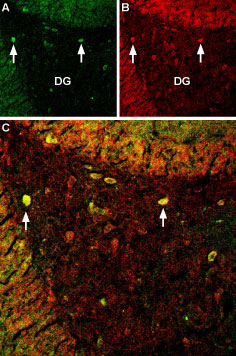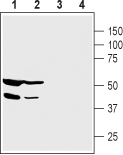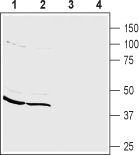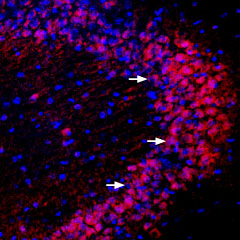
产品详情
文献和实验
相关推荐
免疫原 :见官方网站
亚型 :见官方网站
形态 :液体或冻干粉
保存条件 :-20°C
克隆性 :多克隆
标记物 :见官方网站
适应物种 :见官方网站
保质期 :6个月
抗原来源 :Rabbit
目录编号 :APZ-014
级别 :高
库存 :大量
供应商 :上海信裕生物科技有限公司
宿主 :Rabbit
应用范围 :IH, WB
浓度 :见官方网站
靶点 :见官方网站
抗体英文名 :Anti-PICK1
抗体名 :Anti-PICK1
规格 :25 µl, 50 µl, 0.2 ml
Anti-PICK1
Protein Interacting with C Kinase 1, Protein Interacting With PRKCA1Cat #: APZ-014
Sizes: 25 µl, 50 µl, 0.2 ml
Source: Rabbit
Type: Polyclonal
Applications: IH, WB
May also work in: IC, IFC, IP
Reactivity: H, M, R
Anti-PICK1Application key:
CBE- Cell-based ELISA, FC- Flow cytometry, IC- Immunocytochemistry, IE- Indirect ELISA, IFC- Indirect flow cytometry, IH- Immunohistochemistry, IP- Immunoprecipitation, LCI- Live cell imaging, N- Neutralization, WB- Western blotSpecies reactivity key:
H- Human, M- Mouse, R- RatCLICK HERE TO RECEIVE A 25 µl FREE TRIAL SAMPLE!

Immuno-colocalization of GluA1 and PICK1 in rat hippocampus.Immunohistochemical staining of immersion-fixed, free floating rat brain frozen sections using rabbit Anti-PICK1 antibody (#APZ-014), (1:400) and Guinea pig Anti-AMPA Receptor 1 (GluA1) (extracellular) antibody (#AGP-009), (1:400). A. GluA1 staining (green). B. PICK1 staining (red) in the same section. C. Merge of the two images reveals co-localization in several interneurons (arrows) in the dentate gyrus (DG).
Alomone Labs is pleased to offer a highly specific antibody directed against an epitope of rat PICK1. Anti-PICK1 antibody (#APZ-014) can be used in western blot and immunohistochemistry applications. It has been designed to recognize Protein Interacting with C Kinase 1 from rat, mouse and human samples.
- Applications
- Specifications
- Scientific Background
- Related Products

Western blot analysis of human PANC-1 pancreatic carcinoma cell lysate (lanes 1 and 3) and human HepG2 liver carcinoma cell lysate (lanes 2 and 4):
1, 2. Anti-PICK1 antibody (#APZ-014), (1:200).
3, 4. Anti-PICK1 antibody, preincubated with the control peptide antigen.

Western blot analysis of mouse brain membranes (lanes 1 and 3) and rat brain membranes (lanes 2 and 4):
1, 2. Anti-PICK1 antibody (#APZ-014), (1:200).
3, 4. Anti-PICK1 antibody, preincubated with the control peptide antigen.
Immunohistochemistry

Expression of PICK1 in mouse hippocampus
Immunohistochemical staining of perfusion-fixed frozen mouse brain sections using Anti-PICK1 antibody (#APZ-014), (1:400), followed by anti-rabbit-Cy3 antibody. PICK1 staining (red in the hippocampal CA3 region is detected in neurons (arrows). Nuclei are stained with DAPI (blue).
Immunogen
Peptide (C)RARFSQMRKDVLEK, corresponding to amino acid residues 305-318 of rat PICK1 (Accession Q9EP80). Intracellular, α-helix domain.

HomologyMouse, human - identical.
PurityAffinity purified on immobilized antigen.
FormulationLyophilized powder. Reconstituted antibody contains phosphate buffered saline (PBS), pH 7.4, 1% BSA, 0.05% NaN3.
Standard quality control of each lotWestern blot analysis.
Peptide confirmationConfirmed by amino acid analysis and mass spectrometry.
Storage before reconstitutionThe antibody ships as a lyophilized powder at room temperature. Upon arrival, it should be stored at -20°C.
Reconstitution25 µl, 50 µl or 0.2 ml double distilled water (DDW), depending on the sample size.
Antibody concentration after reconstitution0.8 mg/ml.
Storage after reconstitutionThe reconstituted solution can be stored at 4°C for up to 1 week. For longer periods, small aliquots should be stored at -20°C. Avoid multiple freezing and thawing. Centrifuge all antibody preparations before use (10000 x g 5 min).
Control antigen storage before reconstitutionLyophilized powder can be stored intact at room temperature for 2 weeks. For longer periods, it should be stored at -20°C.
Control antigen reconstitution100 µl double distilled water (DDW).
Control antigen storage after reconstitution-20ºC.
Preadsorption Control1 µg peptide per 1 µg antibody.
Scientific background
PICK1 interacts with the PDZ motifs of several proteins, including: protein kinase C α (PKC α), glutamate receptors (GluRs), prolactin-releasing peptide (PrRP), acid-sensing ion channel (ASICs), dopamine transporter (DAT), Karlirin 7, ephrin type-B receptor 2 (EphB2),ErbB2 / Her-2, TIS21, coxsackie virus and adenovirus receptor (CXADR), and UNC5H.
The proteins interacting with PICK1 have roles in synaptic plasticity, neuronal cell morphology, and mitochondrial-dependent apoptosis. In most of the cases, PICK1 acts as a critical regulator of membrane receptors' subcellular trafficking to modulate neural processes such as learning and memory1.
PICK1 is widely expressed in brain, testis, heart, lung, liver, kidney and muscle2.
Its abnormal expression in brain has been linked to drug abuse and dependence, schizophrenia, and psychosis. Recent evidence suggest that PICK1 may affect human cancer development3,4. PICK1 has also been reported to be expressed in insulin-producing pancreatic beta-cells where it may play a role in the neuroendocrine system5.
References
- Bolia, A. et al. (2012) Proteins 80, 1393.
- Staudinger, J. et al. (1995) J. Cell Biol. 128, 263.
- Zhao, B. et al. (2012) Cell Res. 22, 1467.
- Zhang, B. et al. (2010) Cancer Sci. 101, 1536.
- Jensen, L.J. et al. (2009) Nucleic Acids Res. 37, D412.

上海信裕生物科技有限公司
品牌商实名认证
钻石会员
入驻年限:12年





